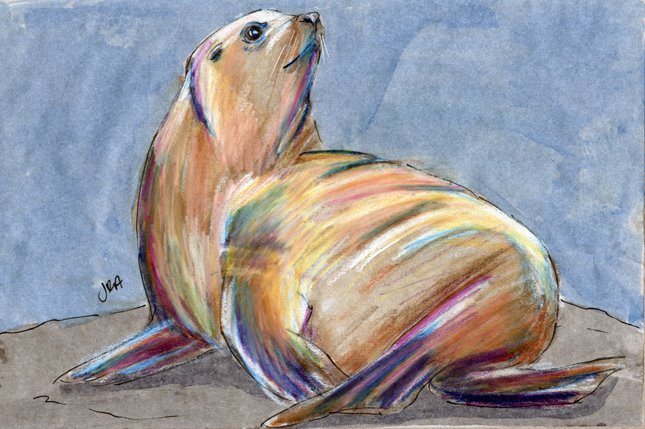The Steller sea lion (Eumetopias jubatus) also known as the northern sea lion, is a threatened species of sea lion in the northern Pacific. It is the sole member of the genus Eumetopias and the largest of the eared seals (Otariidae). Amongpinnipeds, it is inferior in size only to the walrus and the two elephant seals. The species is named for the naturalist Georg Wilhelm Steller who first described them in 1741. The Steller sea lion has attracted considerable attention in recent decades due to significant, unexplained declines in their numbers over a large portion of their range in Alaska.
Adult animals are lighter in color than most sea lions, ranging from pale yellow to tawny and occasionally reddish. Steller sea lion pups are born almost black, weighing around 23 kg (50 lbs), and remain dark for several months. Females and males both grow rapidly until the fifth year, after which female growth slows down considerably, attaining on average 2.5 m (8 feet) in length and 300 kg (660 lbs). Males continue to grow until their secondary sexual traits appear in their fifth to eighth year. Males are slightly longer than the females; they grow to about 3.25 m (10.7 feet) long [2] and have much wider chests, necks and general forebody structure and weigh 600–1100 kg (1300-2500 lbs).[3] Males are further distinguished by broader, higher foreheads, flatter snouts, and darker, slightly tuftier hair around their large necks, giving them a maned appearance. Indeed, their Latin name translates roughly as: “maned one with the broad forehead”.
(From Wikipedia, November 3rd, 2010)
—
Steller’s sea lions breed in massive, noisy rookeries common to most members of this family (4). The males arrive at the haul-out sites in spring and establish their territory on the limited space of the beach; they usually do not feed throughout the breeding season, as they cannot afford to relinquish their hard-won position (7) (8). Females arrive in mid-May to late June and give birth to a single pup; only four days later the female is ready to mate again and the most successful males will aggressively guard, and mate with, up to 30 females (9). Despite mating straight after giving birth, the fertilised egg will not be implanted into the female’s uterus until October (3). Both males and females reach sexual maturity at around three to six years of age, but males are unlikely to breed successfully until their eighth to tenth year due to the fierce competition at rookeries (3). Around nine days after giving birth the female will resume foraging trips to the sea. Most pups are weaned when about one year old, but a mother may continue to suckle her young for up to two or three years (6). The breeding season draws to an end in early July but these sea lions maintain their social lifestyle, being commonly seen on shore throughout the year in groups of tens to hundreds of animals (4) (7). Steller’s sea lions are opportunistic hunters, feeding on a wide range of fish and cephalopods such as squid (6). In Alaska some of the more important prey species are walleye pollock (Theragra chalcogramma), Atka mackerel (Pleurogrammus monopterygius) and Pacific herring (Clupea harengus) (6).
Steller’s sea lion is the largest of the eared seals (members of the family Otariidae), a group that includes fur seals and sea lions (3) (4). The impressive adult males are two and a half times the size of the females; they have large necks, and shoulders covered with a mane of long, coarse hair (2) (3). Both sexes are a light brown, whilst pups are originally black, moulting to the adult coat after three to four months (5). The common name of the species comes from the German naturalist who first described these seals in 1741, George Wilhelm Steller (4). Eared seals are able to control their hind flippers independently, allowing them to be particularly agile on land and, unlike the true seals (family Phocidae), they swim using their foreflippers (4).
Steller’s Sea Lions show remarkable sexual dimorphism. Males are much larger than females. The length of the average male is 282 centimeters, while the length of the average female is only 228 centimeters. The weight of the average male is 566 kilograms, while the weight of the average female is only 263 kilograms. Males also have extremely thick muscular necks and a mane of coarse long hair.
Newborn pups are about 100 centimeters long, weigh 16-23 kilograms, and have a thick, dark brown pelage that molts to lighter after six months. After 2-3 years their color changes again, this time to the adult color.
Male Steller Sea Lions (bulls) are extremely aggressive and territorial. They are large animals and often fight for mates. They do this by throwing their huge bodies up against one another and biting. They come to the breeding ground in May, and this is when the fighting begins. The strongest bull is the male with the largest harem.
Steller’s Sea Lions are not often found in captivity. This is due to their belligerent nature. They are thought to be dangerous to have in zoos, and untrainable for circuses.
They acquire their food by diving into the ocean. The deepest recorded dive by one of these huge beasts was 120-160 yards. This particular animal was found caught in a net, so this number could be slightly inaccurate.
(From EOL via Animal Diversity Web, November 3rd, 2010)
—




